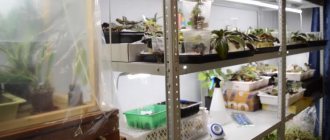The duration and intensity of light plays an important role in the life cycle of the violet (Saintpaulia). As a rule, the best place to place indoor flowers is a windowsill , but this is not exactly suitable for violets.
In summer they need protection from overheating, in winter - from the adverse effects of hot and dry air from batteries. Next, we will tell you in detail what the violet likes - light or shadow , since correctly chosen lighting will allow the plant to actively grow and bloom almost all year round.
What do violets like: shade or sun? Choosing lighting at home
First, let's figure out whether violets like sunlight. In nature, violet grows in warm climates with a predominance of clear sunny days. Being under the forest canopy, it is illuminated by diffused light with partial darkness.
In nature, violets are not exposed to direct sunlight.
Important! The optimal illumination for violets is soft diffused or shaded light for 10-13 hours.
Despite the fact that Saintpaulia is a shade-tolerant plant, it stops developing when there is less than 8 hours of daylight , which can cause its death.
If the violet is provided with good natural light or compensates for its lack with an artificial light source, then it can be grown in any part of the room. Incorrect lighting is one of the main mistakes in caring for violets:
- the flower does not like the scorching and bright sun , so it is better to cover the shelf or stand for Saintpaulia with a thick light curtain;
- if the window is directed south, then it is better to place the violet in a corner or at the back of the room;
- Window sills of northern or eastern windows are optimal for cultivation .
The development of violets is no less adversely affected by short daylight hours (less than 8 hours) and low intensity of rays in winter. At this time, the plant needs illumination with a phytolamp.
Natural
Knowing whether violets love the sun, when cultivating them in a temperate climate zone in natural light conditions, it is necessary to take into account the time of year:
- from October to March - it is permissible to keep the violet in direct sunlight all day long;
- from May to September - in the interval from 10 a.m. to 4 p.m., direct sunlight is shaded by 60-70%, and up to 10 a.m. in the morning, as well as after 4 p.m., cultivation in direct sunlight is permissible;
- if the weather is cloudy, the plant does not need shading.
In cloudy weather, violets need not be shaded.
Speaking about whether violets like direct sunlight, it is worth noting that varieties with dark leaves are more resistant to bright light , they can be placed on window sills closer to the glass, and on shelves - in the center of the lamp.
Since violets have a rather capricious attitude towards light, when growing them on a windowsill without lighting, it is recommended to place them in the following order:
- 1st row from the window - varieties of violets with dark green foliage;
- 2nd row - with straight leaves of medium green color and wavy dark green leaves;
- 3rd row - with wavy light green leaves and heavily pubescent leaf blades, the growth of which requires strong shading.
In this way, you can select varieties of violets for light and dimly lit windows.
Artificial
Natural light is optimal for obtaining full flowering violets. But in conditions of its deficiency in the autumn-winter period, plants must be supplemented with artificial lighting .
This combination provides:
- spectrum as close as possible to natural, necessary for good development of violets and bright color of petals;
- the duration of daylight hours necessary for the formation and flowering of buds.
In the autumn-winter period, inexpensive fluorescent lamps ; their spectrum in this case is not decisive:
- fluorescent lamps distribute light evenly over a larger area than other types of lamps;
- they are installed at a distance of 20 cm from the top point of the bush.
Typically, the lamps are placed slightly higher, and then the height of the plants is adjusted using stands.
Violets that are located on a windowsill or next to a window are best illuminated with an LED strip:
- the tape should have a cool white color with a power of 15 - 25 watts per m2;
- power depends on the location of the window relative to the cardinal directions and shading by trees or buildings;
- The turn-on time of the LED strips is regulated by a timer.
Lighting with LED strip.
If it is not possible to grow Saintpaulias in natural light, artificial lighting will come to the rescue.
Watering violets and humidity.
Watering violets is one of the most important points in caring for violets. For irrigation, you can use tap water, letting it sit in an open container for 1-2 days. It’s even better to soften tap water (Water for watering violets). The temperature of the water for irrigation should be higher than the temperature of the air and soil in the pots. Experience shows that room temperature water is too cold for Saintpaulias; they need warmer water, especially in winter, several degrees higher than the air temperature in the room. Watering with cold water leads to rotting of the roots and plants die en masse in winter.
Violets tolerate some drying out of the soil more easily than waterlogging. Violets should be watered when the top layer of soil becomes slightly dry to the touch. You can water from above, avoiding water getting on the plant, and from below into the tray under the pot. Excess water should be removed from the pan 15-20 minutes after watering. Once every one and a half to two months, to remove dust, it is recommended to wash the plant leaves under the tap with lukewarm water, preventing it from getting into the pot.
The optimal air humidity for our plants is 50-60%, but adult specimens are often content with less (30-40%) humidity at the correct temperature and regular watering. Sprouted leaves, children, and transplanted plants especially need high humidity. They are covered with plastic bags or kept in special greenhouses.
Air humidity, of course, affects the decorativeness of Saintpaulia, but still is not a determining factor for it.
Is it possible to grow completely under artificial light?
In artificial lighting conditions, violets grow and develop well , thanks to this:
- Saintpaulia can be propagated by leaves all year round;
- place large collections regardless of the location of windows and shelf space.
When installing artificial lighting, it must be taken into account that the process of photosynthesis requires blue and red spectrum.
apply to artificial lighting of violets :
- During the period of formation of peduncles, the duration of illumination is increased from 10 to 12-14 hours, or the light intensity is increased, including not one, but several lamps, or the violet is raised closer to the lamp;
- In order not to cause leaf burn, the length of daylight is increased gradually, adding 30 minutes every two days;
- The timing of turning on the lamps is important for plants: it is preferable to do this at the same time every day.
To regulate lighting, use a mechanical or electronic timer that turns on and off at the right time.
Violet pot size.
It is better to use plastic pots for violets. The diameter of the pot is gradually increased with each transplant as the plant grows. It is believed that the diameter of the plant should be three times the diameter of the pot. The plant should not be planted in pots that are too large, as the volume of soil mixture will not be absorbed by the roots, and this can lead to rotting of the root system.
For young plants separated from the mother plant, pots with a diameter of no more than 5 cm (about 100 ml) are suitable. When the children grow up, you can use pots with a diameter of 7-8 cm for a long time. For adult specimens, pots with a diameter of 9-10 cm are suitable, this is the maximum size limit; the height of the pot should be approximately equal to its diameter. You should not use pots with a diameter of more than 10 cm, this will prevent the violet from blooming profusely.
When planting, under no circumstances should you compact the soil too much, since dense soil will not be well saturated with water, and once saturated, it will take a long time to dry, the roots will grow slowly and may rot. Just pour soil into the pot, place a rosette in the center, straighten the roots and fill it with soil on top. When pouring soil on top, lightly tap the pot on a flat, hard surface - this will slightly compact the soil.
Thus, good care for violets means sufficient lighting, optimal temperature, proper watering and humidity, high-quality soil and a small pot.
Organization of additional lighting
To properly organize artificial lighting, pots of violets are placed on shelves or racks.
Types of lamps
Conventional incandescent lamps are not suitable for growing violets:
- they have an inappropriate emission spectrum;
- low efficiency;
- emit a lot of heat, which is harmful to the flower.
Illumination with incandescent lamps is unacceptable, because they may cause burns.
The lighting source is usually linear fluorescent lamps , which come in white, cool white and warm white spectrums. They are made in the form of tubes with a diameter of 26 mm and differ in length, which correlates with power:
- a lamp 60 cm long corresponds to a power of 18 W;
- 90 cm long - 30 W;
- length 120 cm - 36 W;
- length 150 cm - 54 W.
The size of the lamp and its power are selected based on the area of the illuminated area. When choosing a lamp, you need to consider that:
- the shorter the lamp, the less it will last (the service life of an 18 W lamp is about six months, and a 36 W lamp is almost a year). After this period, the luminous flux weakens, although this is not visually noticeable;
- The luminous flux produced by two 18 W lamps is less intense than from one 36 W lamp.
Fluorescent lamps are filled with a small amount of mercury. As long as the lamp is intact, its use is completely safe.
Carefully! A broken fluorescent lamp is dangerous to your health; it is disposed of at special points.
are also effective . Their main advantage compared to other lamps:
- high energy efficiency;
- Easy to attach to any surface and in any position.
The downside is the fairly high cost.
Distance to outlet leaves, maximum number of hours of switching on per day
Lamps are fixed on shelves according to certain rules:
- the interval between the shelves is determined by the distance from the light source to the leaves of the flower;
- shelves for standard varieties of violets are placed at intervals of 40-50 cm, while the distance of the lamp from the bush should be 30-35 cm;
- for mini-varieties of violets, maintain an interval between shelves of 25-30 cm.
Organization of lighting at standard shelf heights.
In this case, it is necessary to take into account the height of the pot and the design of the lamp . For example, with a height of pots of 10 - 12 cm and a lamp thickness of 7 cm, the gap between the shelves is about 45 cm. When installing LED strips, the distance between the shelves will be much smaller - about 25 cm.
The most comfortable light mode for violets is 12 hours of light, 12 hours of darkness . If the plants show that there is not enough light, the lighting period can be increased to 15 hours a day. If this does not help, you will have to change the design of the rack: reduce the gap between the lamp and the flower, or hang another lamp.
Lamp power calculation
When planning shelves for violets, you should focus on the dimensions of a standard lamp:
- for shelves 70 cm long, 18 W lamps are installed;
- for 130 cm shelves - 36 W lamps.
The number of lamps also correlates with the width of the shelves:
- one lamp provides the necessary illumination for a shelf about 30 cm wide;
- two lamps - shelves 50 cm wide.
When calculating lighting for violets, you need to consider that:
- per 1 cm2 of shelf area, the light flux from fluorescent lamps should be 0.7-0.9 Lumens;
- per 1 cm2 of shelf area, the light flux from LED lamps or strip should be 0.22-0.44 Lumens.
Based on this, a shelf measuring 96x38 cm (area 3650 cm2) needs to provide light flow:
- produced by fluorescent lamps - 2550-3280 Lumens;
- produced by LEDs (lamp or strip) - 800-1600 Lumens.
The optimal light flow is the one that is closest to the maximum (1300 - 1700 Lumens per shelf). For example, for a shelf 100x38 cm, the luminous flux should be 840-1680 Lumens.
Advice! The temperature on the upper shelves is always slightly higher than on the lower ones, so it is better to place young plants on them.
Soil for violets.
The soil for violets should be airy and retain moisture well. To make the soil moisture-absorbing and breathable, natural minerals – perlite and vermiculite – are added to it. It is useful to add a small amount of finely crushed charcoal. Violets need good drainage. You can use foam chips or expanded clay.
Also, when choosing land, the acidity of the soil is very important. For Saintpaulia, a slightly acidic, close to neutral, reaction is required - that is, a pH in the range of 5.5-6.5. Perfect for growing violets and rooting cuttings Peat substrate Klasmann (Klasman) TS1.
How does a lack or excess of light affect the growth and development of a plant?
Whether violets need light, they themselves will tell you with their appearance:
- if the young leaves develop well and the flower stalks rise above the rosette, then the violet has enough light ;
- elongated petioles, too thin leaf blade, leaves pointing upward, the violet stops growing and blooming - a sign of insufficient light ;
With a lack of light, the leaves begin to stretch.
- in good light, the leaves of variegated varieties are brightly colored;
- the leaves fall down, over the edges of the container, the color is light, with a yellowish tint, the petioles are shortened, the rosette is thickened - long daylight hours (more than 14 hours);
- short peduncles, pale color and smaller flowers, short flowering period - excess light.
Flower shape - bell
Violets, whose flowers resemble bells in shape, are not able to fully open due to the structural features of the peduncle: the fused bases of the petals. There are several specimens of this species worthy of home breeding.
Admiral
Flowers are cornflower blue with wavy edges. The variety is classified as semi-double. The leaves have decorative value: they have a white edge on a dark green background.
Sea wolf
Why they gave such a name to soft lilac terry violets is not clear. The variety has a large dark green bunch of leaves in a rosette. Blooms luxuriantly. The petals are wavy, arranged in 2 rows. With proper care they grow up to 8 cm in diameter.
Chanson
One of the easiest types of violets to care for. It blooms magnificently, producing several buds at once. The color is blue with pink spots. It is impossible to find two completely identical flowers.
Diseases
All plant ailments can be divided into 4 groups:
- Viruses . The most common infectious disease is fusarium. Rotting begins at the roots, then envelops the entire flower. Fusarium has no cure. The best thing that can be done is to remove the violet from other plants and get rid of the virus-infected soil.
- Bacteria . Putrefactive bacteria appear on damaged areas (cut or transplanted flowers) and affect the entire violet, starting with the leaves. The treatment is simple - immediately remove all rotten parts.
- Parasites . Insects (aphids, mites) begin to destroy the plant from the leaves, then move to other parts of Saintpaulia. They get rid of pests with special medicines.
- Fungus . The leaf plates are covered with small white crumbs, similar to flour. The flower can be healed by treating it with a fungicide.
Transfer
Over time, the soil in which the plant blooms is depleted and its replacement is simply necessary. The easiest way to transplant a violet is transshipment . Without violating the integrity, the flower, along with a lump of earth, is moved to another pot. The same method is suitable for replanting garden viola.
The most unfavorable time for transplantation is winter. Due to lack of sunlight, Saintpaulia takes root less well.
We recommend watching a video about how to properly transplant violets into new soil:
Favorable conditions
When choosing a good place to grow Saintpaulia, the best solution is shelves or special racks with lighting. You can even use a regular cabinet. All you need is to provide your favorite indoor plants with proper lighting , which will allow them to achieve the highest degree of decorativeness. This is quite simple to do; you just need to fix the lamps above the flowers at a distance of at least 20 centimeters. Thus, the optimal distance between racks or shelves should be at least 55 centimeters.
The plants themselves should be positioned so that the outer leaves of neighboring Saintpaulias do not touch. Moreover, the number of lamps directly depends on the depth of the shelf and its size. Florists recommend installing shelves whose depth will be approximately 50 centimeters. Another important condition is the width of the shelves for growing Saintpaulias, thanks to which it will be convenient for the owner of this type of indoor flowers to turn the pots on different sides to the light to ensure full photosynthesis.
It is worth considering the features of the lamps you will use. As a rule, a strong flow of light is concentrated in the middle of the lamp, and at its edges it is weaker.
For this reason, plants with dark green leaves should be placed closer to the center of the rack, as they absorb more light than plants with pale green foliage.
Kinds
The species and varieties described below are only a small part of the entire diverse world of violets , which is popular with flower lovers. Let's consider their features.
All about indoor flowers and photos of varieties
To decorate your apartment and fill it with the enchanting aroma of flowers, it is better to choose the following varieties of violets.
Rosemary
A medium-sized velvet flower with luxurious ruffled petals . The soft pink hue pairs beautifully with the white border and bright blue splashes.
The magic of love
Large double flowers in a marsala shade. The snow-white edging creates a spectacular color contrast.
We recommend watching a video about the violet variety “Magic of Love”:
Sea wolf
Large openwork petals are royal blue. Over time, Saintpaulia loses its richness and acquires soft blue notes.
We recommend watching a video about the violet variety “Sea Wolf”:
Bridal bouquet
The most delicate creation of nature is represented by white corrugated stars with jagged edges. Many gardeners prefer this particular variety because of its ease of care .
We recommend watching a video about violets of the “Wedding Bouquet” variety:
Black Pearl
Cap blooms and a rich purple color accord are the hallmark of this type of Saintpaulia.
We recommend watching a video about the violet variety “Black Pearl”:
https://youtu.be/KAfP-oJgrZA
Chateau Brion
Petals of noble ruby color have a porcelain texture and a ribbed white border. When blooming, the flowers are miniature, but after a certain time they reach impressive sizes .
We recommend watching a video about the Chateau Brion violet variety:
Outdoor varieties
Below are the most popular types of violets for growing outdoors.
Horned
Luxurious landscape design solution. Small flowers create delicate compositions and exude a unique aroma. There are several subspecies of horned violet, each of which has a special color scheme .
We recommend watching a video about the “Horned” violet variety:
Wittrock
It offers several varieties, united by playful flowering and ease of care. A great option for decorating a veranda or garden. It is valued for its ability to tolerate replanting in a blooming state.
Manchurian (Chinese)
Luxury in miniature. Looks great in spring in rocky gardens.
Medicinal properties
Amazing violets are not only incredibly beautiful, but also very useful. The plant has a rich chemical composition, which includes tannins, organic acids, essential oils and many other important trace elements needed by the body. The flower has an antiseptic, expectorant, anti-inflammatory, choleretic and soothing effect.
Only garden and wild violets (pansies, Wittrock violets) have healing properties . Indoor beauties are not suitable for the treatment and prevention of illnesses.
In folk medicine, the plant is popular as an excellent cough remedy. Decoctions and tinctures are made from the dried upper part of the violet, which facilitate the removal of mucus and gently soothe a sore throat.
A simple recipe for cough decoction: pour a spoonful of dried raw material into a glass of hot water and leave for an hour. The optimal dosage is 100 ml 4 times a day.
We must not forget that even natural healers have their side effects and contraindications . Tinctures and decoctions are not recommended for use:
- pregnant and breastfeeding women;
- children under 2 years old;
- with hepatitis.
Important : You cannot take the healing plant for more than a month. In case of overdose, nausea and vomiting, as well as various rashes on the body, are possible.
Top dressing
It is necessary to feed the violet only during the period of flowering growth; in the autumn-winter months it is better not to overload the plant with excess minerals.
In general, for full development, violets need phosphorus and potassium (for forcing flowers) and nitrogen (for leaf growth). Young plants need nitrogen-containing fertilizers, while mature plants need potassium-phosphorus fertilizers. If an adult plant is “overfed” with nitrogenous fertilizers, it will not bloom.
Reproduction
At home, a productive method of propagating violets for further cultivation has been chosen by flower growers for a long time. It is simple and accessible. This is the propagation of Saintpaulia by leaves. You can propagate flowers all year round, but it is better in spring and summer.
How to grow violet from cuttings
For cuttings, select a fully developed Saintpaulia leaf with a 1 cm petiole. Place it in a container of water, peat-sand mixture or sand. The petiole will take root in a month. In two months, young leaves will appear.
When propagating by leaf cuttings, it may happen that the daughter plants do not inherit all the varietal qualities of the mother specimen. In order not to “lose” a beautiful violet, you need to root several leaves. For example, out of three young plants, only one or two will completely inherit the characteristics of a given variety.
Dividing bushes into rosettes
When growing violets, rosettes form on the plant bushes. They are also called children. Over time, the developing rosettes cause the flower to become very cramped in the pot. Saintpaulia may stop growing and not bloom. Exit in the following steps:
- remove a flower from a pot;
- carefully separate all rosette roots;
- Plant rosettes in separate pots.
If the plants are not sick, then they can be divided into rosettes during flowering.
Actions after flowering
Some types of violets can bloom 8-10 months a year. After a long period of flowering, Saintpaulia should rest. All efforts and resources used to be spent on buds, now they are aimed at the growth of the upper tiers. To restore strength, the flower is fed with potassium and nitrogen. Do this no more than once a month.
What actions are taken when the flowers wither:
- old flower stalks are cut off, new ones are left;
- the rosette is transplanted into another soil, the basis of which can be sphagnum moss;
- the lower leaves are removed;
- When transplanting, the trunk is buried down to the cuttings;
- add soil on top and water.
If the roots are damaged during planting, the violet will take about a month to recover. After transplantation, new flower stalks may appear; it is better to remove them. The violet should rest, get stronger, grow new roots and please its owners with abundant flowering for more than one season.
Why doesn't it bloom?
Some viola pleases with flowering all year round, while others are only pleased with green foliage . The main reason is non-compliance with plant care rules.
Main violations:
- lack of heat and light;
- the burning rays of the sun;
- unsuitable potty;
- dry indoor air;
- improper watering.
Various violet diseases and parasite damage should not be ruled out.
Description
Attention : Currently, more than 400 varieties of violets are known. External characteristics vary depending on the type and conditions in which the flower is grown.
Garden violet belongs to the genus of subshrubs. The shape of the bush is compact or spreading, with a height of 10 to 40 cm. The shoots grow from one root collar. The broadly oval leaves are strongly drooping and have wavy edges. Petals can be either one tone or combine several different shades, combining into incredible patterns. The color range of viola is varied: from soft blue to bright orange.
The indoor violet is small in size and has a short stem .
The leaves come in various shapes, most often green, oblong with jagged edges. Saintpaulia flowers have a simple, semi-double or double type of structure. The diameter of the inflorescences reaches 5-7 cm. Like the viola, each species has its own unique color. There is an opinion that white violets give a woman strength to maintain comfort in the house, red ones protect money, blue ones drive away sadness and melancholy, and purple ones fill the housewife with wisdom and contribute to finding harmony in the family.
Origin
The violet was first discovered more than a hundred years ago, in Africa, in the Uzambara Mountains . Baron Adalbert von Saint-Paul, walking with a beautiful lady, noticed an unusual plant, which he immediately decided to send to his father, a collector of rare flowers.
Later, botanist Hermann Wendland determined that the interesting find belonged to the Gesneriaceae family. A wonderful creation of nature was presented at the exhibition and was appreciated by fans of strange plants. The flower received alternative names in honor of its discoverer (Saintpaulia) and the place in which it was found (Usambara violet).
In ancient Greek mythology, there is a legend that a young nymph turned to Zeus with a request to hide her from Apollo, who was in love with her. The Thunderer turned the girl into a wondrous flower and hid her in the shadows from the bright light. While walking, the daughter of the Lord of Olympus was picking a bouquet, but was kidnapped by Hades and accidentally dropped the violets on the ground.











